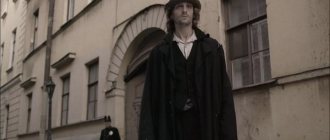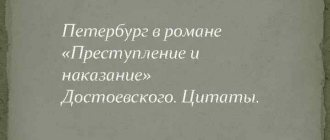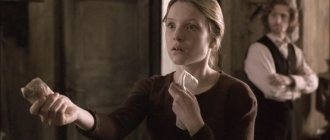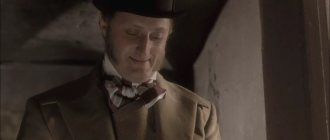Essay: Raskolnikov’s dreams in the novel “Crime and Punishment”
(504 words) Psychological novel “Crime and Punishment” by the great Russian writer F.M. Dostoevsky is replete with a variety of literary techniques designed to reveal to the reader the history of the characters. One of the most important places in the work is occupied by the description of the dreams of the main character of the book.
The first dream overtakes the hero at the moment when he stands at a crossroads in life. Raskolnikov, being in a half-insane state, cannot decide to kill the old woman. In a dream, he sees an episode from his childhood: while walking with his father, he encounters a cheerful company on a cart, which a thin, tired nag cannot budge. In a rage, the owner and his friends brutally beat the horse with a whip, then use a shaft for this, and ultimately finish off the unfortunate animal with an iron crowbar. Little Rodion cries and screams, looking at this cruelty, hugs and kisses the dying animal, and then rushes at the flayer with his fists. The author showed what disgust Raskolnikov has for violence. The main character understands that he is not capable of taking a person’s life, if even the death of a dumb horse evokes such an emotional response in him. At this moment, Rodion is ready to give up killing. However, the circumstances are completely different.
The second dream acts as a counterweight to the first. It is in it that Raskolnikov’s dream is reflected, which he intends to realize with the help of his theory. We see a lifeless desert, in the heart of which the hero has created a small blooming oasis. In this dream, the reader is presented with the exorbitant pride of the protagonist, who sees himself as the savior of humanity, destined to create a small, ideal earthly paradise even at the cost of the destruction of the rest of the world.
The murder of the old pawnbroker becomes a turning point in the narrative, changing the position of the hero. Now he is not a self-doubting, proud theorist, but an accomplished killer. And the new dreams fully correspond to his current situation. Chaotic, restless visions filled with screams torment Raskolnikov. So, in the third dream, police lieutenant Ilya Petrovich brutally beats the owner of the house in which the main character rents a room. The policeman personifies justice in the eyes of Raskolnikov - terrible, cruel and unfair, ready at any moment to bring down his punishment on Rodion.
The fourth dream is the peak of the protagonist’s mental suffering. Raskolnikov encounters a murdered old woman who shamelessly laughs at him. Filled with anger and horror, the protagonist grabs an ax and tries to kill his victim a second time, but he only continues to laugh. She is joined by dozens more voices, which also mockingly laugh at Rodion’s futile attempts. This dream indicates the proximity of the main character's breakdown. Gradually, Raskolnikov comes to realize the meaninglessness of murder. He couldn't save anyone, couldn't prove anything to anyone. And, even if the main character himself does not admit it, he gradually takes the path of repentance and redemption.
Raskolnikov’s last dream is already in Siberia, in hard labor. It is in this dream that the messages of Dostoevsky himself are most clearly visible. Rodion sees a world in which all people have become infected with mysterious parasites, instilling in everyone the idea of his chosenness and greatness. As a result, the world plunged into chaos, people quarreled among themselves and destroyed themselves. This dream is a warning to the writer himself, according to whom, the new capitalist world, which has forgotten about Christian love of humanity and placed human egocentrism on a pedestal, is inevitably moving towards its destruction.
Dreams in Dostoevsky's novel, reflecting in detail the inner state of the hero, develop along with him. The hero’s visions go from Raskolnikov’s tossing at the very beginning to the writer’s prophecy in the epilogue.
If you are missing something in this work, please report it in the comments to the Many-Wise Litrekon, he will correct everything.
Author: Mikhail Shchepin
Popular writings
- Essay Is it possible to do miracles with your own hands?
What is a miracle for you? For me, a miracle is something extraordinary and unexpected. Something that makes you smile and gives you a feeling of boundless happiness. What makes you want to move forward and not stop - Essay Only a person who loves his people is able to understand and love other peoples.
The essence of our world is that its central core is the part that we know best, where we feel protected, where there is no need to find out where any expectations have already been or will be fulfilled - Essay based on the painting by Aivazovsky The Coast of Dalmatia (description)
The artist Ivan Konstantinovich Aivazovsky was an avid traveler. He could not imagine life without conquering new heights and visiting other lands. During his life he made countless visits
Dreams in Dostoevsky's novel “Crime and Punishment” | Literary guru
Guru · 01/30/2018
Rodion Raskolnikov, as you know, came up with his own theory, dividing people into “trembling creatures” and “those with the right,” thereby allowing “blood according to conscience.”
Throughout the entire work, the inconsistency of this hypothesis is proven. One of the author’s outstanding means in the fight against the ideology of hatred is dreams.
They represent symbols, the decoding of which is the key to understanding Dostoevsky’s complex and multi-layered plan.
- 1 Raskolnikov's dreams
- 2 Dreams of Svidrigailov
- 3 The meaning and role of dreams
Raskolnikov's dreams
- About a slaughtered horse. Already the protagonist's first dream shows his true traits and reveals his ability to be compassionate. Raskolnikov is transported to childhood, sees a horse being beaten with a whip by brutal people.
This episode proves the ambiguity of the character of the young theorist, who, while empathizing with a poor animal in his dream, in reality is preparing to kill a person. This dream becomes a symbolic expression of a world filled with violence, suffering and evil.It contrasts the tavern, as the personification of an ugly, base world, and the church, with which Raskolnikov has sad but bright memories. The motive of salvation from the terrible world of reality with the help of faith will continue to be traced throughout the novel.
- About Africa.
Shortly before his fatal act, Raskolnikov saw Africa in a dream. He sees an oasis, golden sand and blue water, which is a symbol of purification. This dream is the antithesis of the hero's terrible daily life. An important detail is that Rodion dreams of Egypt. In this regard, the motif of Napoleonism appears in a dream.The Egyptian campaign was one of the first undertaken by Napoleon. But failure awaited the emperor there: the army was struck by plague. So what awaits the hero is not a triumph of will, but disappointment at the end of his own campaign.
- About Ilya Petrovich .
After the murder of the old pawnbroker, the young man is in a fever. The heat provokes two more dreams. The first of them is about Ilya Petrovich, who beats the owner of Rodion’s rented home. It shows that Raskolnikov cannot tolerate bullying of a person, no matter how bad he may be. It is also not difficult to understand that Rodion Romanovich Raskolnikov has a fear of formal punishment (the law). This fact is personified in the figure of the policeman. - About the Laughing Old Woman .
Raskolnikov returns to the crime scene, where the murder he committed is almost repeated. The difference is that this time the old woman laughed, mocking the hero. This may indicate that by killing the old woman, he also killed himself. Frightened, Raskolnikov flees the crime scene. In this dream, Rodion feels the horror of exposure and shame that actually torments him. In addition, this nightmare confirms that the main character was not morally capable of murder, it was painful for him and became the reason for his further moral self-destruction. - Sleep in hard labor.
The hero's last dream finally confirms the inconsistency of Rodion's hypothesis. “In his illness he dreamed that the whole world was condemned to be a victim of some terrible, unheard of and unprecedented pestilence” - the killer sees how his plan for the “salvation” of all things is being realized, but in practice it looks terrible.As soon as the line between good and evil disappears thanks to sophistical speculation, people plunge into chaos and lose the moral foundations on which society is based. The dream is contrasted with the theory: the hero believed that “unusually few people are born with a new thought,” and the dream says that the world is collapsing from the lack of “pure people.” Thus, this dream contributes to Raskolnikov’s sincere repentance: he understands that what is needed is not pretentious philosophizing from the onion, but sincere and good deeds, opposed to evil and vice.
Dreams of Svidrigailov
Svidrigailov is a character who also has symbolic dreams imbued with deep meaning. Arkady Ivanovich is a man fed up with life. He is equally capable of both cynical and dirty actions and noble ones. Several crimes lie on his conscience: the murder of his wife and the suicide of a servant and the girl he insulted, who was only 14 years old.
But his conscience does not bother him, only dreams convey the hidden side of his soul, unknown to the hero himself; it is thanks to his dreams that Arkady Ivanovich begins to see all his meanness and insignificance. There he sees himself or a reflection of his qualities, which terrify him.
In total, Svidrigailov sees three nightmares, and the line between sleep and reality is so blurred that it is sometimes difficult to understand whether it is a vision or reality.
- Mice . In his first dream, the hero sees mice. The mouse is considered the personification of the human soul, an animal that quickly and almost imperceptibly slips away, like a spirit at the moment of death. In Christian Europe, the mouse was a symbol of evil, destructive activity. Thus, we can come to the conclusion that in Svidrigailov’s dream the rodent is a harbinger of trouble, the inevitable death of the hero.
- About a drowned girl. Arkady Ivanovich sees a suicidal girl. She had “an angelically pure soul that tore out the last cry of despair, not heard, but brazenly scolded in the dark night...”. It is not known exactly, but there were rumors about Svidrigailov that he seduced a fourteen-year-old girl. This dream seems to describe the hero's past. It is possible that it was after this vision that his conscience awakens in him, and he begins to realize the baseness of the actions from which he previously received pleasure.
- About a five year old girl . In the last, third dream, Svidrigailov dreams of a little girl, whom he helps without any malicious intent, but suddenly the child is transformed and begins to flirt with Arkady Ivanovich. She has an angelic face, in which the essence of a base woman gradually emerges. She has a deceptive beauty that outwardly covers the human soul. This five-year-old girl reflected all of Svidrigailov’s lust. This was what scared him the most. In the image of demonic beauty one can see a reflection of the duality of the character of the hero, a paradoxical combination of good and evil.
Having woken up, Arkady Ivanovich feels his complete spiritual exhaustion and understands: he has no strength or desire to live further. These dreams reveal the complete moral bankruptcy of the hero. And, if the second dream reflects an attempt to resist fate, then the last one shows all the ugliness of the hero’s soul, from which there is no escape.
Raskolnikov's dreams and their meaning in the novel Crime and Punishment by Dostoevsky
In the novel “Crime and Punishment” F.M. Dostoevsky pays great attention to the inner world of the main character. The reader can see not only Raskolnikov’s thoughts and experiences, but also his dreams. Throughout the work they occur in different episodes, each with its own emotional overtones and meaning.
The first dream turns out to be heavy and gloomy. Gray and black tones flash repeatedly in it; the only spots of color are the green church dome and the drunkards' shirts. The action takes place in Raskolnikov's early childhood. Rodion is afraid of the anger of the men in the tavern, but just a few steps away from this most unpleasant place there is a church, which the hero thinks about with warmth. The dream seems to hint at the ending of the novel, in which faith in God will be the way out of the darkness. It also shows images of death and an axe. The dream arose against the background of the emotions Rodion experienced at the sight of a drunk girl on the boulevard, and led to the emergence of thoughts of murder.
The next dream is no more pleasant than the first. It is a cacophony of ugly sounds: squeals, wheezing, curses and screams. The nightmare not only scares Rodion, it makes a hole in a seemingly undeniable theory. Nastasya believes that these sounds are the cry of his boiling blood. But in fact, it’s more likely not about his blood, but about the one that he personally shed by killing the unfortunate women. The main image in this scene is the stairs. It symbolizes the path that the criminal must go through to achieve redemption.
Two more dreams relate to Raskolnikov’s theory. The first is New Jerusalem, paradise, a tiny island in the ocean of sadness and grief, which will be created by Rodion-Napoleon himself. The second is a refutation of the previous one. It is more like an earthly hell, full of human torment and hatred. This is a contrast between a fictional reality and one that could actually come true if the theory were true.
Raskolnikov's dreams are another way to fully reveal the mental anguish of a suffering and lost hero. Rodion is confused and full of doubts, but dreams do not lie and show what is really happening in his soul and, in a sense, tell him the right path. F.M. Dostoevsky not only worked with their help on the character’s psychologism, but also presented other problems of the work in an allegorical form, allowed readers to anticipate the denouement, and expressed his own position on the theory.






